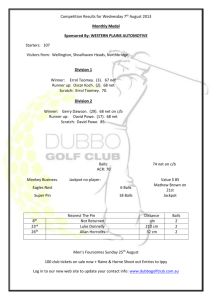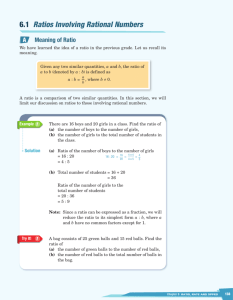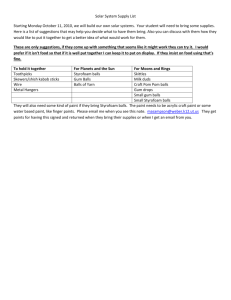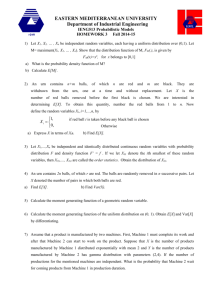Alt exam - garsia at york
advertisement
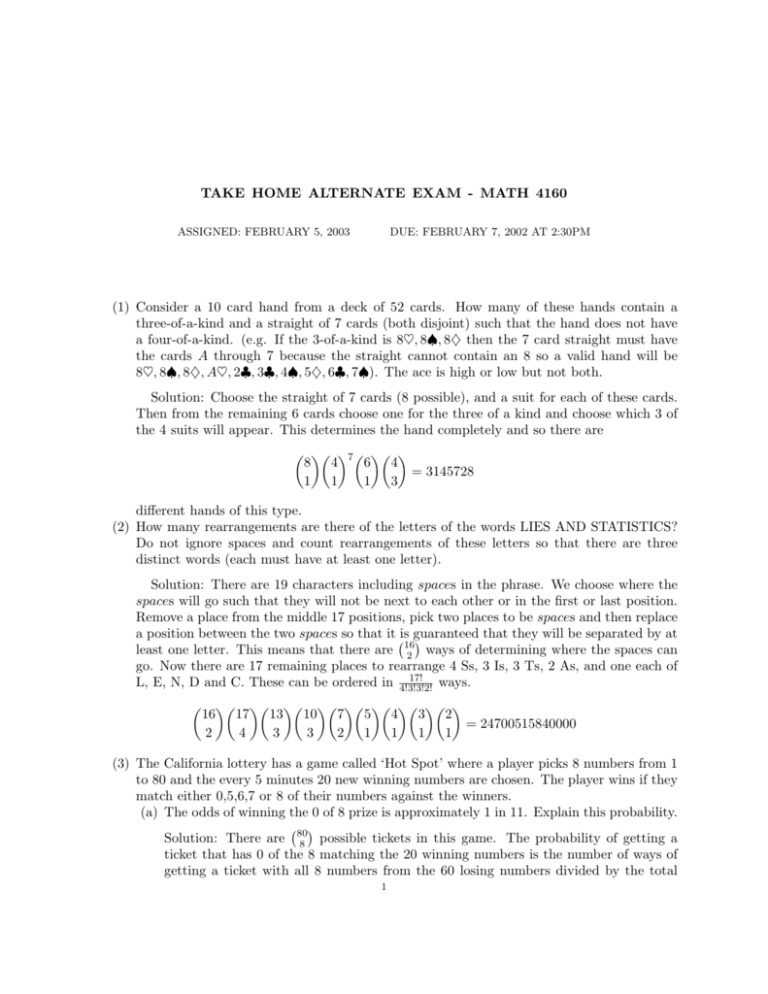
TAKE HOME ALTERNATE EXAM - MATH 4160 ASSIGNED: FEBRUARY 5, 2003 DUE: FEBRUARY 7, 2002 AT 2:30PM (1) Consider a 10 card hand from a deck of 52 cards. How many of these hands contain a three-of-a-kind and a straight of 7 cards (both disjoint) such that the hand does not have a four-of-a-kind. (e.g. If the 3-of-a-kind is 8♥, 8♠, 8♦ then the 7 card straight must have the cards A through 7 because the straight cannot contain an 8 so a valid hand will be 8♥, 8♠, 8♦, A♥, 2♣, 3♣, 4♠, 5♦, 6♣, 7♠). The ace is high or low but not both. Solution: Choose the straight of 7 cards (8 possible), and a suit for each of these cards. Then from the remaining 6 cards choose one for the three of a kind and choose which 3 of the 4 suits will appear. This determines the hand completely and so there are 7 8 4 6 4 = 3145728 1 1 1 3 different hands of this type. (2) How many rearrangements are there of the letters of the words LIES AND STATISTICS? Do not ignore spaces and count rearrangements of these letters so that there are three distinct words (each must have at least one letter). Solution: There are 19 characters including spaces in the phrase. We choose where the spaces will go such that they will not be next to each other or in the first or last position. Remove a place from the middle 17 positions, pick two places to be spaces and then replace a position between the two spaces so that it is guaranteed that they will be separated by at least one letter. This means that there are 16 ways of determining where the spaces can 2 go. Now there are 17 remaining places to rearrange 4 Ss, 3 Is, 3 Ts, 2 As, and one each of 17! L, E, N, D and C. These can be ordered in 4!3!3!2! ways. 16 2 17 4 13 3 7 5 4 3 2 = 24700515840000 2 1 1 1 1 10 3 (3) The California lottery has a game called ‘Hot Spot’ where a player picks 8 numbers from 1 to 80 and the every 5 minutes 20 new winning numbers are chosen. The player wins if they match either 0,5,6,7 or 8 of their numbers against the winners. (a) The odds of winning the 0 of 8 prize is approximately 1 in 11. Explain this probability. Solution: There are 80 8 possible tickets in this game. The probability of getting a ticket that has 0 of the 8 matching the 20 winning numbers is the number of ways of getting a ticket with all 8 numbers from the 60 losing numbers divided by the total 1 2 ASSIGNED: FEBRUARY 5, 2003 DUE: FEBRUARY 7, 2002 AT 2:30PM number of tickets. 60 8 80 8 ≈ 1 11.32936019 (b) The odds of matching 7 of 8 numbers is approximately 1 in 6232. Explain this probability. Solution: The probability of getting a ticket that has 7 of the 8 matching the 20 winning numbers is the number of ways of getting a ticket with all 1 number from the 60 losing numbers and 7 numbers from the winning 20 divided by the total number of tickets. 60 20 1 2 7 ≈ 80 6232.270629 8 (4) Prove one of the following identities by giving a combinatorial interpretation to both sides of the equation and explain why they must be equal: k n k+` n−k X k n−k = k+` ` ` r k−r r=0 Proof: Consider a set of numbered balls labeled 1 through n. The number of ways of picking k + ` of them and coloring the remaining n − k − ` red, then picking ` of these distinguished balls and coloring those blue, and coloring the remaining k balls green is k+` n (the left hand side of this equation). That is, the left hand side of the equation k+` ` counts the number of ways of partitioning n numbered balls into three sets: ` blue balls, k green balls, and n − k −` red balls. The quantity kr n−k k−r is the number of ways of picking k balls to color green, r of which are labeled 1 through k and k − r are labeled k + 1 through n. Since for any fixed r these are disjoint events and every way of choosing k balls from the n has r of them labeled 1 P through k with r equal to 0 or 1 or 2 or . . . or k, then nk = kr=0 kr n−k k−r . Therefore n n−k the right hand side of this equation is actually equal to k ` . This is also equal to the number of ways of choosing k balls to color green followed by choosing ` numbered balls to color them blue and coloring the remaining n − k − ` balls red. Therefore the two sides of this equation are equal. OR m−r X m − k n + k m+n+1 = r s r+s+1 k=s−n NOTE: There was a mistake on the exam and the sum didn’t have the correct range. I copied this from a book containing a list of “known binomial identities” and this one was listed incorrectly. Proof: Fix the numbers m, n, r and s. The left hand side of this equation counts the number of paths which fit inside of an (m + n − r − s) × (r + s + 1) rectangle which start at the point (0, m + n − r − s) and connect the point (r + s + 1, 0) using only south (0, −1) and east (1, 0) steps. TAKE HOME ALTERNATE EXAM - MATH 4160 3 Consider a path counted by the left hand side of this equation. Let a be the height of the horizontal step in the r + 1st column of the (m + n − r − s) × (r + s + 1) rectangle. Now a ranges between 0 and m + n − r − s and every path which has a horizontal step at height a in the r + 1st column is a path in an (m + n − r − s − a) × (r) rectangle followed by a horizontal step and then a path in an (a) × (s) rectangle. This means that the number of paths in the (m + n − r − s) × (r + s + 1) rectangle is equal to m+n−r−s X a=0 m+n−s−a a+s . r s Now do a substitution of the variable in the sum a = n + k − s, then the sum ranges over k from s − n to m − r and the expression in the equation above is equal to the right hand side of the expression we are proving. (5) Use inclusion-exclusion to solve the following question. Clearly write out descriptions of sets whose use will appear in the application of the inclusion-exclusion principle: How many 8 letter sequences are there with at least one letter appearing exactly twice. Solution: Let AX be the set of 8 letter sequences with the letter X appearing exactly twice (where X is any letter a-z). This means that we are counting the set |Aa ∪ Ab ∪ Ac ∪ · · · ∪ Az |. Now principle because it is easy 6apply the inclusion-exclusion 4 2 to count the sets |AX | = 8 8 6 8 6 4 25 , |A ∩ A | = 24 , |A ∩ A ∩ A | = Y X Y Z 2 X 2 2 2 2 2 23 , |AW ∩ AX ∩ AY ∩ AZ | = 8 6 4 2 2 2 2 2 and the intersection of more than 4 sets is 0. 26 26 26 |Aa ∪ Ab ∪ Ac ∪ · · · ∪ Az | = |AX | − |AX ∩ AY | + |AX ∩ AY ∩ AZ | 1 2 3 26 − |AW ∩ AX ∩ AY ∩ AZ | 4 26 8 26 8 6 26 8 6 4 6 4 = 25 − 24 + 232 1 2 2 2 2 3 2 2 2 26 8 6 4 2 − 4 2 2 2 2 4 ASSIGNED: FEBRUARY 5, 2003 DUE: FEBRUARY 7, 2002 AT 2:30PM WHEN YOU SUBMIT THIS EXAM please sign the following statement. I attest that I have completed this exam myself without help from anyone else and I have not discussed the problems on this exam with other students in the class. Mike Zabrocki —————————————————————— Ahhhh! I lied. I looked at the classes exams before I wrote this solution (but just a little) and I swear that I did these on my own when I wrote up the solutions.


